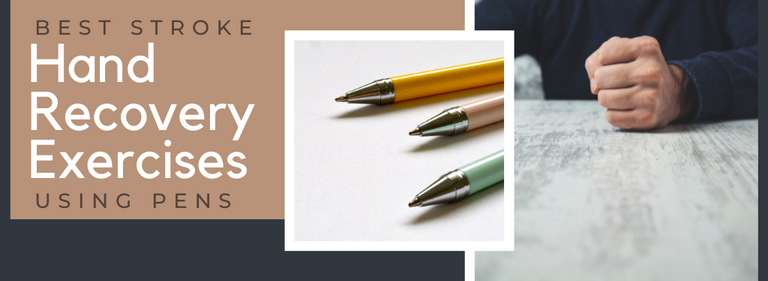Best Stroke Hand Recovery Exercises Using Pens

Strokes can be one of the leading causes of serious long-term disability. A stroke can lead to a reduction in mobility in more than half of stroke survivors from the age of 65 and older. Loss in hand function, strength, and dexterity can result from a stroke. These conditions and impairments are determined by the location and severity of the stroke. Today, there are many ways to regain hand function after a stroke or neurological injury.
Regaining Hand Function
Boost your hand function by using everyday objects like pencils, pens, and markers with these best stroke hand recovery exercises. These exercises are for people in the final stage of hand recovery. In other words, whether you have had a stroke, have another neurological condition, or are recovering from surgery, these exercises are for you. The one great thing about using everyday objects is it allows you to take therapy wherever you go, like at home in the car or at a doctor's office.
Watch Step-by-Step Directions
Exercise 1: Translation
First, one exercise you can perform with a pencil, pen, or marker is translation. With the object in your hand, try pulling it into your hand by curling your fingers slowly, followed by uncurling your fingers and opening your hand.
Similarly, you can also place the object lying face down on a flat surface and slowly curl your fingers with the object in hand to make a fist. Slowly, release your fingers and straighten your fingers to a flatter position, with the object underneath.
Exercise 2: Rotation
Secondly, lay the pencil, pen, or marker on a flat surface. Pick up the object and rotate it 180 degrees. Use as many fingers as you like to pick up the object. Do this multiple times.

Exercise 3: Climbing
Third, position the pencil, pen, or marker upright in your hand. When ready, slowly climb up the object using your fingers. Finally, when at the top, work your way back down the object. If you are having a hard time withholding the object upright and climbing, lay the object flat on a solid surface and climb horizontally across the object.
Exercise 4: Supination and Pronation of the forearm
Lastly, practice supination and pronation of the forearm. For instance, that is turning your pencil, pen, or marker over one way or the other. In other words, pick the object up, rotate it, and release it out of your hand. Repeat.
Get Your Hand Back Using These Recovery Exercises
There are many exercises proven to increase dexterity and strength. With time and persistence, patients can use this strategy to overcome the physical limitations caused by a stroke. A patient’s treatment plan will be determined by the extent of the weakness in the affected hand.
Along with hand exercises, recovery devices, and treatment plans are all tools that can kick start and enhance your recovery. Check out our hand recovery devices, like the SaeboGlove, here. Don’t forget about our Saebo YouTube channel filled with free stroke recovery tips, exercises, and product information.

All content provided on this blog is for informational purposes only and is not intended to be a substitute for professional medical advice, diagnosis, or treatment. Always seek the advice of your physician or other qualified health providers with any questions you may have regarding a medical condition. If you think you may have a medical emergency, call your doctor or 911 immediately. Reliance on any information provided by the Saebo website is solely at your own risk.



